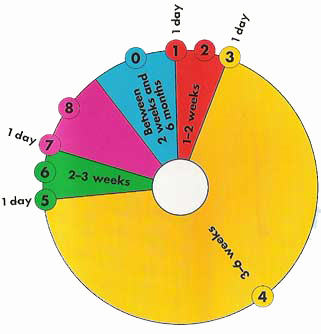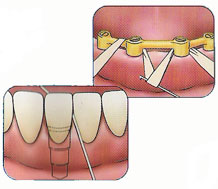|
|
|
|
|
|
|
DENTAL IMPLANTOLOGY |
|
|
 |
The best thing about sharks' teeth ...
is that they always grow again. On their own, and in only eight
days. that's why such a greedy ocean monster can easily gobble up
things and risk a tooth. but, in humans, once a tooth is lost,
it's gone forever.


For centuries,
even the best of dentists couldn't help. They had ways and means
of replacing the tooth crown but not the root. But times have
changed. For about twenty years, dentists have been able to "get
to the root" of gaps between the teeth by replacing the missing
roots with tiny pins called "implants". Your dentist is bound to
have explained the basics to you. when he gave you this FRIATEC
Aktiengesellschaft booklet.
|
|
 |
What is an implant?
Implants are tiny pins made of
especially compatible pure titanium which are inserted into the bone of
the jaw. The dentist can attach crowns, bridges or removable dentures to
these artificial roots. In approximately three to six months, the bone
grows tightly around the surface of the implant and grips it firmly in
the jaw.
|
|
|
| |
The following are critical when selecting the implant . |
| |
 |
The amount
of bone available, |
| |
 |
the firmness of the bone,
and |
| |
 |
the time at which the
implant is inserted. |
|
|
|
|

|
The amount of bone
available
The dentist checks that adequate bone is available for inserting
the implant. If too little bone is available for an implant, in many
cases it can be built up surgically. |
|
| |
 |
The firmness of the bone
The dentist decides on a threaded or non-threaded implant depending on
how firm the bone is. |
 |
|
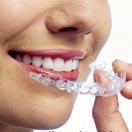 |

|
The time
at which the implant is inserted.
The implants can either be inserted immediately after the tooth is
lost (immediate implant placement) or a long time after wards delayed
implant placement). Implants shaped like the roots of natural teeth
are used for immediate implant placement. In general, the sooner the
implant is inserted the better. Once a tooth is missing, no chewing
forces are excerted on this area and the jaw bone recedes. Immediate
implant placement prevents this. Should delayed implant placement be
the only treatment possible, smaller, cylindrical implants are used as
less bone is usually available. |
Shows a cylindrical implant,
a stepped threaded implant
and an apical threaded implant
(IMZ TwinPlus)
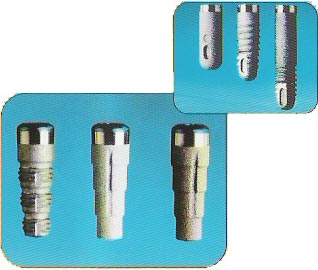
Shows a stepped threaded implant
and stepped cylindrical implants
(FRIALIT-2) |
|
|
|
|
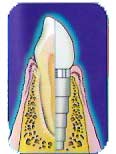 |
FRIATEC implants
As teeth and jaws vary from person to
person, implants and abutments have to meet various requirements. The
FRIATEC Supply two different systems-
FRIALIT -2 and IMZ TwinPlus
As FRIALIT -2 implants resemble natural
tooth roots, they are used for immediate implant placement. Their
dimensions are matched to the bone volume of the remaining jaw ridge.
The abutments for this system are especially suitable for single
crowns. They can also be used for retaining bridges and dentures.
IMZ TwinPlus implants are used in
jaws which have been reduced in height and width because the teeth
have been missing for a long time. The abutments in this system can be
used for complex bridges and bars as well as for single crowns. |
|
|
 |
|
|
|
In principle,
there are four different indications for inserting implants: |
|
 |
A gap between the front teeth:
One single tooth is missing
from between the teeth. The gap is bordered on both sides by natural
teeth.
|
 |
A wide gap between the teeth:
One or more teeth are
missing from between the teeth. The gap is bordered on both sides by
natural teeth.
|
 |
Free-ends:
One or more teeth are
missing from the end of the row. The natural teeth only border one
side.
|
 |
All teeth are missing:
All teeth are missing from
the top and / or bottom jaws.
|
|
|
|
|
A gap between the
front teeth
More young than elderly people suffer from gaps between their front
teeth. These single tooth gaps are often caused by accidents but may
also be due to diseased teeth (caries) or gums (periodontitis). In
some cases, the tooth simply never grew. If the gap is in a visible
area of the top jaw, the overall appearance of the face is disturbed
considerably. Not only the aesthetics, but also the health of the
teeth suffer. If a single tooth gap remains untreated for a longer
period of time, the adjacent teeth grow into it. The upper and lower
teeth are displaced and no longer interlock as accurately as they
should. Chewing is adversely affected and, in the long term, the
joints of the lower jaw may become painful. |
 |
|
Conventional techniques involve the dentist closing the gap with a
three unit bridge supported by the two adjacent teeth. These two teeth
have to be trimmed and healthy tooth structure is sacrificed.
Alternatively, an adhesive bridge can be fitted. J:.s its name
implies, it is adhered into place. The adjacent teeth are not trimmed
as extensively but the durability of the bridge is very limited.
A drawback of bridge units is that as they only replace the crown and
not the root, the chewing forces are no longer exerted on the
underlying section of jaw. The bhne is not loaded and, in time, its
volume is reduced. The width and height of the jaws are reduced. In
time, the central unit of the bridge has to be extended toward the
gums.
In this case, an implant is a
better alternative. As the teeth do not have to be trimmed, healthy
tooth structure is preserved completely. In addition, the implant
transfers the chewing forces into the jaw bone and its volume remains
unchanged. |
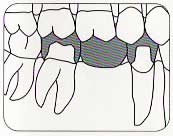
Shows a crown on an implant |
|
|
 |
|
 |
A wide gap between
the teeth
In principle, a wide gap between the teeth has the same
effects as a single tooth gap - beginning with the adverse aesthetics
and ranging to the disturbed equilibrium of the chewing movements up
to the pains in the jaw joints. As several teeth are missing, the
complaints are more severe. Wide gaps also impede speech especially.
If the dentist does not intervene, these unpleasant conditions will
progress from year to year. |
|
How does the dentist close a wide gap? Conventional methods call
for a multi-unit bridge. As with single tooth gaps, healthy
adjacent teeth on both sides have to be trimmed to support the
bridge. Another aspect has to be taken into account for wide gaps:
As this type of bridge is longer than that required for single
tooth gaps, sufficient adjacent teeth have to be available to
support it. If this is not the case, a removable partial denture
is . the only alternative.
This type of dentures may cause problems. In certain
cases, the patient may suffer choking, and in most cases,
difficulties with speaking and chewing.
Bridges or single implants are definitely easier and
more pleasant in such cases. Bridges can be supported on implants
and natural teeth. If single crowns are fitted, each implant
receives its own crown. |
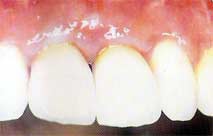
Shows a gap filled with implants
|
|
|
|
 |
|
Free-ends
If teeth are lost with
advancing age, this process usually begins with the back, "grinding"
teeth. This results in a so-called "free-end" or shortened row of
teeth. This type of gap is bordered toward the front with natural
teeth. The powerful back teeth, with their large, bumpy chewing
surfaces are designed for grinding food and preparing it for
digesting. If one or more of these teeth are missing, not only the
chewing movements are disturbed. The remaining teeth move slowly
toward the free-end, which loosens the contacts between the teeth. The
teeth in the upper and lower jaws are displaced (refer to "single
tooth gaps"). In the long run, the joints of the lower jaw may cause
problems. |
|
 |
Free-ends are difficult to restore with conventional restorative
methods. Natural teeth are only available on one side for supporting a
bridge. A "classic" bridge needs supports on both sides. However,
bridges or removable partial dentures can be used which are. supported
on "palatal bars" (upper jaws) or lingual bars (lower jaws). |
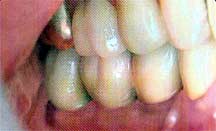 |
|
Palatal bars pass over the roof of the mouth, lingual bars pass
beneath the tongue and over the inside of the lower jaw. These types
'of denture could be felt as foreign bodies. They also impede speech
and chewing.
An implant, instead of the tooth missing
from the end of the row, may be inserted to ad as the second bridge
support. This type of bridge is supported on one end by a natural
tooth and on the other end by an implant. This type of bridge is a
fixed restoration which really feels like natural teeth. Instead of
being supported on an implant and natural tooth, a bridge can also be
supported on implants only. A so-called tooth-for-tooth restoration is
also excellent for closing free-ends. Every missing tooth is replaced
with an implant and single crown. |
|
|
|
All teeths are
missing
Upper and / or lower jaws with no
teeth lead to considerable problems. Chewing and speaking are impeded considerably. as the
face is no longer supported by the teeth, it goes limp and locks
"old". in severe cases, the patients withdraw more and more. |
 |
|
The only conventional type of treatment for this condition is a
removable full denture. This type of denture is relatively easy to
stabilize on the upper jaw because a large palate can be included
which sucks the denture in to place. despite this, patients often
consider the denture a foreign body: It impedes chewing and specking
and may cause chocking.
It is much more difficult to fit a stable
full denture to the lower jaw. The denture is held in place by its
arched base which fits over the ridge of the jaw. The volume of the
jaw ridge decreases with age and the denture slowly loses its grip. |
|
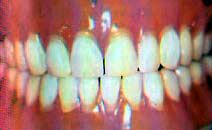 |
The dentist has to reline it, which flattens the curvature of the
denture base and reduces the retention. If the denture has to be
relined several times, it will become loose and chewing / specking will
be more and more difficult.
The dentist can use implants to
stabilize full dentures. For example, a bar can be constructed which
is supported on two or four implants and retains the denture securely.
Even a fixed restoration can be fitted - this method has been in use
successfully for decades for lower jaws. It involves fixing a bridge
to six or eight implants inserted around the entire lower jaw. |
|
|
More
information about oral health visit:
www.pathanamthittadental.com |
Requirements for
inserting an implant
Until a few years
ago, the volume of the bone was one of the most important criteria for
inserting implants. Nowadays, the dentist can operate and "build up"
the bone to enable implants to be inserted. However, certain illnesses
or anomalies may rule out or restrict implant placement.
For example: |
 |
| |
 |
Blood
coagulation disturbances |
 |
 |
Metabolic
diseases (e. g. uncontrolled diabetes) |
 |
Changes in
the mucous membranes and jaw bone due to diseases. |
 |
Diseases
which require certain medicines to be taken for many years (e. g.
cortisone preparations or chemotherapeutical measures) |
 |
Narrow gaps
between the teeth, unfavorable position of the upper and lower jaws. |
|
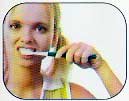 |
Your age is usually not particularly relevant. However, adolescents
should not be fitted with implants until they have finished growing
.completely. A doctor can diagnose whether growth
has been concluded.
The patient should also be informed in advance that implants require
particularly conscientious and thorough oral hygiene. Also important:
smokers must do without cigarettes for the first few months after
implant placement. Otherwise, the implant healing process will be
endangered. |
| |
|
|
|
|
|
|
|
|
 |
Pre -operative
examination and treatment
Your dentist checks your general medical condition - usually
using a questionnaire -, asks about previous or acute diseases and
weather / which medication you take. If in doubt, he will contact
your family doctor.
|
He examines your gums, teeth and jaw bones. X-rays and models of
your jaws are required for this thorough evaluation. Depending on
the result of his examination, he starts with the first stages of
the treatment, such as cleaning the teeth professionally, which
involves removing all plaque and tartar, treating diseased mucous
membranes or carious teeth. In certain cases, he may enlarge the
volume of the bone.
|
|
|
 |
Implant
placement
The implant is usually inserted under
local an anesthesia and sterile conditions. The dentist and assistant
wearing operating gowns and you will be covered with sterile sheets.
As soon as the injection
takes effect, the dentist opens the gums above the jaw ridge. This
area, called the implant site, is then carefully prepared for implant
placement. The important is then removed from its sterile packaging
and inserted in to the implant site. Cylindrical implants are
carefully tapped into place, respectively, threaded implants screwed
in. The implants are then sealed with screws which must be tightened.
Finally, the gums are sutured into place again. |
 |
| |
After the surgery, a moist compression bandage is placed in position
for you to bite on for at least half an hour. The dentist will often
apply a splint, i.e. a kind of dressing, for the first few days after
the operation. However, this is not required in many cases. As the
anesthetic causes drowsiness, you should have someone accompany you
home and not drive yourself. |
|
Healing takes place very quickly in the mouth. The area may swell
during the first few days, which is slightly painful. External cooling
helps the swelling subside faster or prevents it completely (refer to
page 13). These complaints are usually over in two or three days. If
they are not, tell your dentist during the first check-up two or three
days after the operation. The stitches can be removed one or two weeks
later. |
|
|
|
|
After implant placement
Immediately after implant
placement
Do not eat or drink hot drinks until the anesthesia has worn off
completely. |
 |
|
|
|
|
|
The next four
to six weeks |
|
 |
Avoid very strenuous
activities. |
 |
Clean your teeth, gums and
implant following your dentist's instructions. |
 |
Do not smoke |
 |
Always wear your temporary
restoration (Miniplast splint or denture), remove and clean it after every
meal. |
 |
After more extensive operations
(e. g. building up bone), do not wear your full denture for six weeks.
After minor operations it can be trimmed and lined with soft material. |
|
|
|
|
Healing can only take place undisturbed if the implant and bone are not
displaced. Therefore, you must ensure that this area is not loaded during
the "healing period". Under no circumstances should you touch the area
repeatedly with your fingers or tongue. On average, the healing period
lasts three to six months - if the bone has been built up surgically, it
lasts six to nine months. The exact duration depends on your personal
healing process. Ask your dentist! |
 |
|
|
|
|
|
 |
The
restoration
The first procedure involves taking an impression of your
teeth in the dental practice. The gum former is replaced with an
impression post during this procedure. The dental technician uses this
impression to cast a model of your jaw, which reproduces the
anatomical conditions exactly, for fabricating the correct type of
restoration. He produces crowns, bridges or dentures, depending on the
dentist's instructions. |
If single crowns are to be fitted, the dentist screws medically pure
titanium crown fittings into the implants. The visible crown, which
is usually coated with porcelain, is either cemented to the crown
fitting or screwed to it with a tiny screw. Your dentist can also
provide you with a temporary restoration until your own restoration
is ready.
If bridgework is fitted to IMZ TwinPlus
components, elastic buffers called intra mobile elements can be
screwed in. They cushion the chewing forces exerted on the bridge.
This safeguards the bone beneath the implant. These buffers are
advisable during the first two years after delayed implant placement
because, during this period, new bone forms around the implant which
first has to adapt to the chewing forces
|
|
The buffers can be replaced during the six monthly check-ups. |
|
Two types of restoration can be fitted to jaws where all the teeth are
missing: removable full dentures and fixed bridges. Removable dentures
are fixed in place by screwing bars, ball-head fittings or conical
posts, called telescopic crowns, into the implants. Special retaining
fittings in the denture connect with them to hold the denture in
place. These connectors can also be released.
Bridges, which span the
entire jaw are screwed directly onto several implants. The result is a
fixed restoration which makes the patient feel he has his own teeth.
However, much more effort is required than for a full denture.
|
|
|
|
|
Use a toothbrush to
clean the surfaces of crowns, bridges and dentures. A normal
toothbrush cannot reach the spaces between single crowns and
bridge units. An inter dental brush is recommended for these areas.
If the inter dental spaces are even too narrow for an inter dental
brush, use dental floss - or cotton cleaning strips for bars.
|
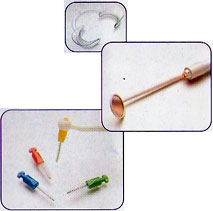 |
|
|
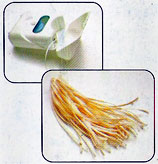 |
Once you have loosened
the deposits with a toothbrush and dental floss, they are easily
rinsed off with a water jet. Please note that the use of a water jet
alone is not sufficient.
It's good to know that everything you need for perfect oral hygiene
isin the practical FRIATEC EasyClean hygiene set which FRIATEC
assembled specifically for implant patients. This set is ideal for
home use and traveling.
|
|
|
|
| |
It's not only important to
know what to use, but also how to go about it. The correct brushing
technique is essential for cleaning the teeth thoroughly. Ask in your
dental practice. Your dentist and his staff will be pleased to show
you how to use tooth brushes, dental floss and water jets properly.
Please take their advice and help create the best conditions possible
to ensure that your treatment is successful - long term! |
 |
|
|
Basic
flossing
Crowns
|
|
Composite
Restorations Implant Over
Denture Metal Free
Ceramics Metal Ceramics
Post and Core |
|
I Dr. Samuel K. Ninan
I Dr. Maya Mathai I
Dr. Shukoor I I Treatments I
Doctors
I Facilities I
Consultation
I Contact Us I
Home l |
|
More information about oral
health visit:
www.pathanamthittadental.com |
|
|
|
DENTAL
EMERGENCY Contact: +91 9447440004 |
|
|



















